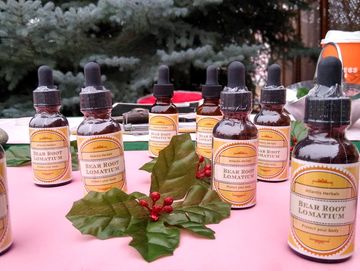Products
Tinctures
Tinctures are diluted and concentrated extracts of foods

Bear Root Tincture
Tincture made from the Fernleaf Biscuitroot.
There are 2 formulas a 5 week maceration, which is an standard maceration time and an 8 week formula that makes the tincture stronger, leaving the root in the solvent for a longer period of time.
Sizes available 1,2,4 glass dropper bottles and 8 and 16 oz glass refill bottles (funnel included with purchase)
5 week-$18.00, $32.00, $60.00, $116.00 and $228.00
8 week-$23.00, $42.00, $80.00, $156.00 and $308.00

other offerings
Single herb Thyme, Sage, Oregano, Rosemary, Peppermint, Lemongrass, Basil and Red Raspberry leaf in potato vodka. Each plant or herb supports your health in it's own unique way.
Sizes available 1,2,4 oz glass dropper bottles
(larger sizes available upon request)
$9.00, $16.00 and $30.00
Products
Tinctures
Tinctures are diluted and concentrated extracts of foods

For External use Only
Avocado Seed Tincture (in rubbing alcohol and for external use only) Avocado seeds are packed with antioxidants and anti-inflammatory compounds to ease arthritis pain, swelling and inflammation.
Available in 2, 4,6, 8 and 12 oz glass jars
$10.00, $14.00, $18.00, $22.00 and $30.00
Products
Spray bottles
for use with the Avocado Seed Tincture

For External use Only
1 oz plastic and 4 oz glass Spray bottles for use with the Avocado Seed Tincture
$1.00 for the plastic and $3.50 for the glass bottle
Products
Poultices
a soft, moist mass of material, typically of plant material or flour, applied to the body to relieve soreness and inflammation and other uses kept in place with a cloth.

Comfrey Leaf for poultices
Comfrey, also known as "knitbone" or "boneset", was traditionally used to help mend broken bones, sprains, bruises, and various skin conditions like rashes, eczema, bug bites, and sunburns. This is largely attributed to compounds like allantoin, which is thought to promote cell regeneration and collagen

Comfrey Leaf for poultices
production, and mucilage, which creates a protective, soothing layer. Studies suggest that comfrey's anti-inflammatory properties, potentially due to rosmarinic acid, may help reduce pain and swelling associated with injuries, muscle aches, and joint problems like arthritis. Leaf sold by the ounce
C
Products
Poultice fabric
Fabric for use in poultices

contact me for current pricing
In poultice applications, fabric serves primarily to hold the poultice material in place, retain heat or moisture, and sometimes to protect the skin from direct contact with the poultice ingredients. Different types of fabric are used depending on the poultice's purpose and the ingredients involved.
Photo Gallery






This website uses cookies.
We use cookies to analyze website traffic and optimize your website experience. By accepting our use of cookies, your data will be aggregated with all other user data.